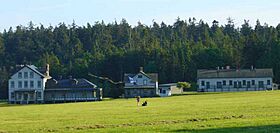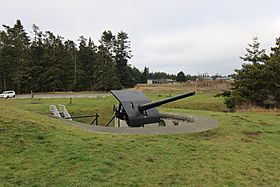Fort Flagler State Park facts for kids
Quick facts for kids Fort Flagler Historical State Park |
|
|---|---|

The parade ground at Fort Flagler State Park, with the hospital building (left) and ranger residence (middle) in the background.
|
|
| Lua error in Module:Location_map at line 420: attempt to index field 'wikibase' (a nil value). | |
| Location | Jefferson County, Washington, United States |
| Area | 1,451 acres (587 ha) |
| Elevation | 102 ft (31 m) |
| Established | 1955 |
| Administered by | Washington State Parks and Recreation Commission |
|
Fort Flagler
|
|

Gun emplacement at Fort Flagler
|
|
| Location | Jefferson County, SE of Port Townsend on Marrowstone Island |
| Nearest city | Port Townsend, Washington |
| NRHP reference No. | 76001882 |
| Added to NRHP | May 3, 1976 |
Fort Flagler Historical State Park is a fun place to visit. It's a public park that used to be a military fort. The park is located at the very top of Marrowstone Island in Washington.
It covers about 1,451 acres of land. From the park, you can see Port Townsend and Whidbey Island. The park is a great spot to learn about history and enjoy nature.
Fort Flagler State Park: A Historic Place
Fort Flagler was once a very important United States Army fort. It worked with two other forts, Fort Worden and Fort Casey. Together, they guarded the entrance to Puget Sound. This entrance is called Admiralty Inlet.
The three forts were placed to create a "triangle of fire." This meant their big guns could stop any enemy ships. The idea was to protect Puget Sound from any attacks by sea.
A Look Back: Fort Flagler's Story
Fort Flagler was built a long time ago, in 1897. It officially opened in 1899. The fort was named after Daniel Webster Flagler. He was a brave general who fought in the American Civil War. He also led the Army's weapons department.
The fort was an active military base for many years. It helped protect the coast of Washington. However, it closed down in June 1953. Just two years later, in 1955, the land was bought by the state. It then became the state park we know today.
Fun Things to Do at the Park
Fort Flagler State Park offers many exciting activities for visitors. You can explore the park on its many hiking and biking trails. There are also places to camp, including spots for groups.
If you like boating, the park has boat launches. You can even stay overnight in some of the old historical buildings! These include the Hospital Steward's House and the Waterway House. There are also the North and South Non-Commissioned Officers' Quarters.
The park has a museum where you can learn more about the fort's past. It shows exhibits about its history. You can also join guided tours to discover more secrets of the fort. Many groups also hold their meetings and events here.

